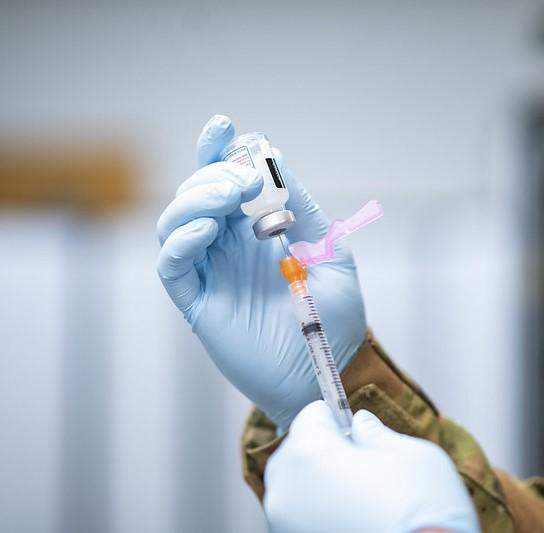A modeling study led by Centers for Disease Control and Prevention (CDC) researchers estimates that COVID-19 vaccination averted 27 million infections, 1.6 million hospitalizations, and 235,000 deaths among US adults from December 2020 to September 2021.
In the study, published yesterday in JAMA Network Open, the researchers extrapolated the number of COVID-19 infections and deaths from hospitalization data from Dec 1, 2020, to Sep 30, 2021. Then they combined the estimates with data on vaccine uptake and effectiveness to estimate the risk of infection, hospitalization, and death.
Vaccination was considered two doses of the Pfizer/BioNTech or Moderna vaccine or one dose of the Johnson & Johnson version.
Impact greatest in 65+ age-group
The CDC investigators estimated that COVID-19 vaccination averted about 27 million infections (95% uncertainty interval [UI], 22 million to 34 million), 1.6 million hospitalizations (95% UI, 1.4 million to 1.8 million), and 235,000 deaths (95% UI, 175,000 to 305,000). Vaccination was estimated to prevent 30% (95% UI, 27% to 33%) of all expected infections, 33% (95% UI, 30% to 36%) of hospitalizations, and 34% (95% UI, 28% to 40%) of deaths over the study period.
The estimated percentage of expected infections, hospital admissions, and deaths prevented rose as vaccine uptake increased over time. From Sep 1 to 30, 2021, COVID-19 vaccines were estimated to prevent 52% (95% UI, 45% to 62%) of infections, 56% (95% UI, 52% of 62%) of hospitalizations, and 58% (95% UI, 53% to 63%) of deaths.
Most estimated averted hospitalizations and deaths occurred in the 65-and-older age-group (759,000 hospitalizations [95% UI, 622,000 to 946,000] and 154,000 deaths [95% UI, 105,000 to 214,000], respectively) and in those aged 50 to 64 (525,000 hospitalizations [95% UI, 454,000 to 646,000] and 66,000 deaths [95% UI, 40,000 to 94,000]).
Estimated hospitalizations averted among Americans 65 and older ranged from 34 (95% UI, 30 to 40) per 100,000 in March 2021 to 484 (95% UI, 389 to 612) in September 2021. In the same age-group, the estimated number of deaths prevented ranged from 6 (95% UI, 2 to 8) per 100,000 in March 2021 to 96 (95% UI, 36 to 153) in August of that year.
Among those aged 50 to 64, vaccination was estimated to have thwarted 10 (95% UI, 9 to 11) hospitalizations per 100,000 population in March 2021 to 327 (95% UI, 233 to 478) in September 2021. Over the same periods, vaccination in that age-group may have averted 0.8 (95% UI, 0.3 to 1.2) to 51 (95% UI, 15 to 88) deaths per 100,000 people.
Regional variations due to vaccine uptake
The number of COVID-19 vaccine-averted infections, hospital admissions, and deaths varied by region owing to differences in vaccine uptake over time. For the entire study period, Department of Health and Human Services (HHS) region 10 (Alaska, Idaho, Oregon, and Washington) had the highest estimated proportion of vaccine-prevented infections (36%; 95% UI, 34% to 39%), hospitalizations (40%; 95% UI, 38% to 44%), and deaths (41%; 95% UI, 36% to 47%).
The lowest estimated percentage of averted infections, hospitalizations, and deaths occurred in HHS region 3 (Delaware, District of Columbia, Maryland, Pennsylvania, Virginia, and West Virginia) (27% [95% UI, 25% to 30%], 28% [95% UI, 26% to 31%], and 29% [95% UI, 23% to 35%], respectively).
From Sep 1 to 30, 2021—the final month of the study period—HHS region 2 (New Jersey, New York, Puerto Rico, and the US Virgin Islands) saw the highest estimated proportion of thwarted infections (63%; 95% UI, 60% to 65%), hospitalizations (64%; 95% UI, 61% to 67%), and deaths (65%; 95% UI, 61% to 68%).
HHS region 4 (Alabama, Florida, Georgia, Kentucky, Mississippi, North Carolina, South Carolina, and Tennessee) had the lowest estimated percentage of averted infections (44%; 95% UI, 42% to 47%), hospitalizations (51%; 95% UI, 48% to 54%), and deaths (52%; 95% UI, 49% to 57%) during that 1-month span.
"Some of the variation in regional-level impact may be explained in part by differences in age," the researchers wrote. "For example, deaths are predominantly experienced by older age groups; thus, regions that have a higher proportion of older individuals may have a higher percentage of deaths averted in the total population despite having lower vaccine coverage."
Reaching the unvaccinated
The authors noted that their estimates are conservative yet illustrate the direct benefits of COVID-19 vaccination.
"This study's findings indicate that COVID-19 vaccination in the US has provided substantial protection against infections, hospitalizations, and deaths," they wrote. "Future models and analyses could estimate the impact of vaccination among individuals younger than 18 years, the benefits of partial vaccination, indirect benefits of vaccination on disease transmission, and the impact of additional primary or booster doses."
In a related commentary, Malia Jones, PhD, MPH, of the University of Wisconsin; Karim Khader, PhD, MStat, of the Veterans Affairs (VA) at Salt Lake City Health Care System; and Westyn Branch-Elliman, MD, of the VA Boston Healthcare System, said that while all modeling study results have some degree of uncertainty, the study finding most affected by this limitation is vaccine effectiveness against hospitalization and death.
"Changes in circulating viral variants, the proportion of the population that has already been infected, policy changes, and changes in behavioral response to the pandemic over time mean that vaccine effectiveness is better conceived as a dynamic rather than a static entity," they wrote. "Thus, it cannot be modeled accurately with a point estimate."
Yet they said the study highlights the need to vaccinate the current roughly one in three unvaccinated Americans.
"Rebuilding trust is essential, and we need evidence-informed strategies for achieving these critical goals," Jones and colleagues wrote. "Identifying and implementing effective interventions will require substantial and sustained investments in health communications research; an understanding of the influence of social media and information bubbles on information spread and impact; public health infrastructure; and boots-on-the-ground, targeted, and individualized approaches."
Without strategies that are evidence-based, they added, "we may find ourselves continuing to wonder why the same COVID-19 vaccines that can reduce risk of death by up to 94% only managed to prevent 58% of deaths."




















